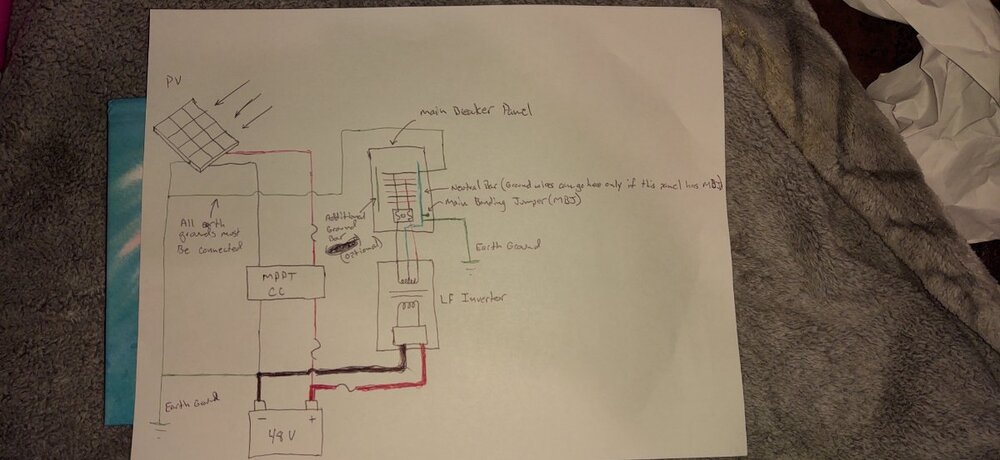PLEASE NOTE: If you had an account with the previous forum, it has been ported to the new Genetry website!
You will need to reset the password to access the new forum. Click Log In → Forgot Password → enter your username or forum email address → click Email Reset Link.
2 hours ago, Sid Genetry Solar said:The frames may be grounded (and often are on commercial installs), but due to the series-parallel wiring methods of solar panels, it's not possible to tie either positive or negative to the grounded frame. Kinda a weird thing if you ask me...a ring of grounded lightning rods around each solar panel it seems 😉
That was my thoughts. I've heard of folks useing some kind of shark washer with the ground wire coming off of it, forgot what they call them, but really, I think if your solar going to get hit by lighting, then I don't care how much you got a ground wire on it or the solar charger, you going to have one bad day. I mean, I've never ever heard of solar panels being a lighting magnet. *laughs* You can't even put a magnet to the frame it won't stick.
The code requires systems operating above 50 V nominal to be grounded. A 48 V battery system doesn't HAVE to be grounded. But a 90 VDC PV system would. Grounding a system like that would automatically tie the AC and DC sides together. In a contracted system, that is, one not likely to be tinkered with by the customer, blow ups only happen from failed components of lightning. But I have a feeling systems represented on this forum probably blow up weekly from wandering screw drivers🤣.
The pic is just one way it could be done. I hope it is clear enough.
12 minutes ago, InPhase said:The code requires systems operating above 50 V nominal to be grounded. A 48 V battery system doesn't HAVE to be grounded. But a 90 VDC PV system would. Grounding a system like that would automatically tie the AC and DC sides together. In a contracted system, that is, one not likely to be tinkered with by the customer, blow ups only happen from failed components of lightning. But I have a feeling systems represented on this forum probably blow up weekly from wandering screw drivers🤣.
The pic is just one way it could be done. I hope it is clear enough.
//content.invisioncic.com/g308908/monthly_2021_04/IMG_20210414_194745162.thumb.jpg.0b20dc7f666bc0d4d59d81f20e4c2fb2.jpg
Well, 😛 I can't see that pic, anyhow, well then I'm good, cause my system is sat at 60pcv. and I'm only dealing with 24v. I just bought a 250ah 24v for $1k 😛 wish these batts came on sale last year or showed up I would have switched to 48v $2k for 13kw isn't bad and considering these batts never been cycle woohoo. Just wow, they are big!!! 15: long 2.2: wide and I think like 6.5: tall. yeah boy.
That was my thoughts. I've heard of folks useing some kind of shark washer with the ground wire coming off of it, forgot what they call them, but really, I think if your solar going to get hit by lighting, then I don't care how much you got a ground wire on it or the solar charger, you going to have one bad day. I mean, I've never ever heard of solar panels being a lighting magnet. *laughs* You can't even put a magnet to the frame it won't stick.
The point of grounding the entire PV array is not directly for lightning and the required grounding wire gauge will likely never handle the instantaneous current of a direct lightning strike though it may take a good portion of it to ground. The reason for bonding or grounding a PV array is to ensure that any charge accumulation on the array makes its way safely to ground while providing a way to ensure the potential between the racking, modules, and charge controllers never exceeds the max rated system voltage. If it ever does due to hardware failure, tracking, corrosion, or short and becomes energized, that charge has a way to go safely to ground to prevent the chance that the system may be floating at several hundreds or even thousands of volts and create a lethal shock hazard.
Lightning rods are installed on high structures to prevent a lightning strike by allowing the accumulated charge between the earth and the atmosphere (charged clouds and ionized air) a low resistance path to equalize before a lightning strike occurs lowering the potential and reducing the chances of a strike from taking place. So the intent is that they will not be struck by lightning as they are preventing it by allowing the charge differential to equalize. If the charge buildup is happening faster than the rate at which it can be dissipated through the lightning protection system then you still have the potential for lightning to strike but at least it might cause less heat damage on it's way to the ground since you are providing it a low resistance path to ground. If your array does take a direct lightning strike, you will likely be replacing/repairing some things to bring everything back to working order but proper grounding helps reduce the risk and helps keep the entire system at or near the same potential.
If you are interested in reading a bit more about this. Here is a link to the basic fundamentals involved sourced from the Feynman lectures.
